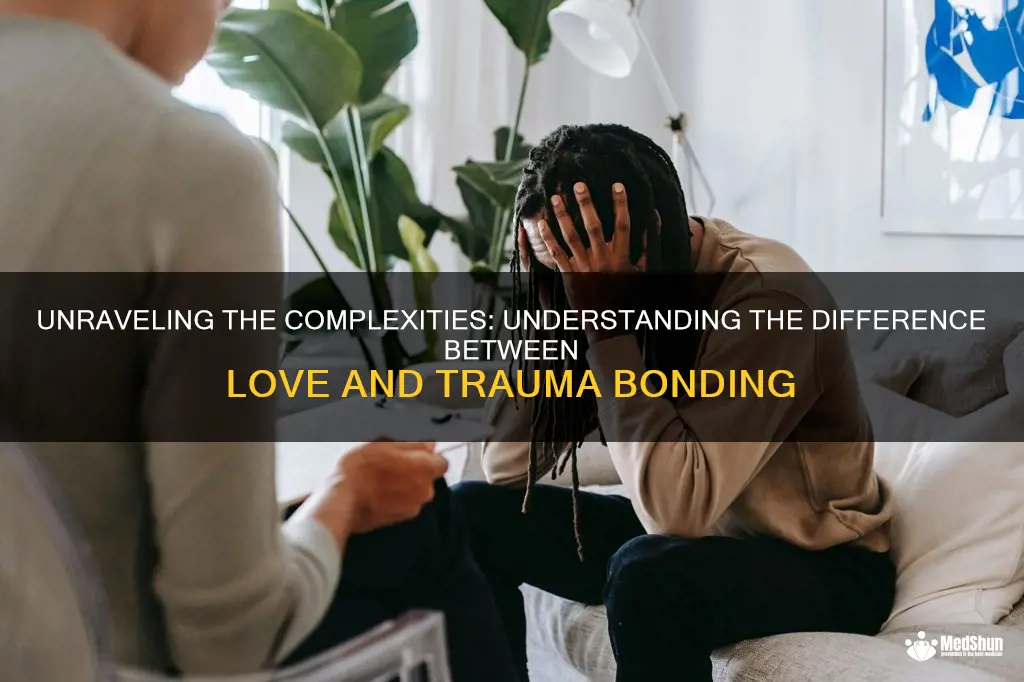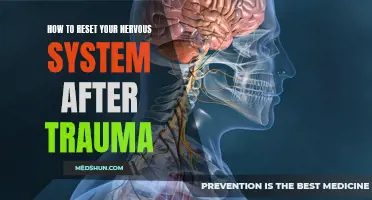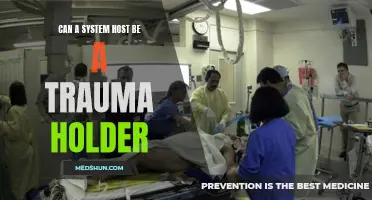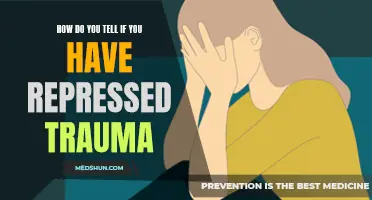
Love and bonding are complex emotions that can be difficult to decipher. Sometimes, it's hard to tell whether the intense emotions we feel are a result of being in love or being trauma bonded. Both experiences can create powerful connections and intense feelings, but they stem from different sources. Understanding the distinction between the two can help us navigate our relationships and make informed decisions about our emotional well-being. So, if you find yourself questioning whether you're truly in love or bound by trauma, buckle up as we dive into the depths of these intricate emotions to find out what's really going on in your heart.
| Characteristics | Values |
|---|---|
| Intense emotions | Love: deep feelings of affection and attachment, Trauma Bond: intense feelings of fear, loyalty, and attachment |
| Strong attraction | Love: drawn to the person on multiple levels, including physical, emotional, and intellectual, Trauma Bond: drawn to the person due to intense and unpredictable dynamics |
| Obsessive thoughts | Love: frequently think about the person in a positive and joyful manner, Trauma Bond: constantly preoccupied with thoughts of the person, even if the thoughts are negative or distressing |
| Dependence | Love: rely on the person for support and companionship, but can also function independently, Trauma Bond: feel a strong sense of dependency on the person and struggle to function without their presence |
| Idealization | Love: see the person through rose-tinted glasses, focusing on their positive qualities, Trauma Bond: have an exaggerated or idealized view of the person, often ignoring or rationalizing their negative behaviors |
| Emotional manipulation | Love: occasional disagreements and conflicts are resolved through open communication, Trauma Bond: experience patterns of manipulation and control in the relationship |
| Cognitive dissonance | Love: generally have a clear idea of the person's character and their own feelings, Trauma Bond: feel conflicted and confused about the person, their actions, and the relationship |
| Lack of self-worth | Love: feel secure and valued in the relationship, Trauma Bond: have low self-esteem and doubt their own worth, believing they deserve the mistreatment |
| Difficulty leaving | Love: may experience sadness or grief when separated, but can maintain a healthy life outside the relationship, Trauma Bond: find it extremely difficult to leave the relationship, even when aware of the harm it causes |
| Healing potential | Love: a healthy relationship with room for growth and improvement, Trauma Bond: usually requires professional help and a significant amount of healing to break free from the bond |
What You'll Learn

Recognizing the Signs of Love or Trauma Bonding
Love and trauma bonding can be difficult to distinguish, especially when emotions are involved. It's crucial to understand the differences so that you can make healthy choices and avoid perpetuating a toxic cycle. In this article, we will explore the signs of love and trauma bonding, helping you recognize which one is at play in your relationship.
Emotional Rollercoaster vs. Consistency
Love encompasses a wide range of emotions, but a healthy relationship tends to have a consistent and stable emotional foundation. If you find yourself constantly experiencing extreme highs and lows in your relationship, it may be a sign of trauma bonding. On the other hand, love is often accompanied by feelings of security, trust, and emotional stability.
Dependency vs. Interdependence
Dependency is a common characteristic of trauma bonding, where one person relies heavily on the other for emotional or psychological support. This dependency often leads to a sense of entrapment and loss of individuality. In healthy love, there is a sense of interdependence, where both individuals support each other while also maintaining their own identities.
Fear vs. Safety
Trauma bonding involves fear and intimidation. You may feel a sense of fear or anxiety when thinking about leaving the relationship, as though you have no choice but to stay. In love, you feel safe and secure in the relationship. There is open communication, trust, and the freedom to express yourself without fear of judgment or retaliation.
Control vs. Respect
Trauma bonding often involves power dynamics and control. One person may exert control over the other, leading to a loss of autonomy and decision-making ability. In a healthy love relationship, both individuals have equal say and respect for each other's boundaries. There is a sense of teamwork and compromise rather than dominance and control.
Negativity vs. Positivity
Trauma bonding is often characterized by negativity, criticism, and a constant feeling of walking on eggshells. Love, on the other hand, is marked by positivity, appreciation, and mutual support. While all relationships have their ups and downs, love relationships tend to have a higher ratio of positive experiences.
Isolation vs. Support
Trauma bonding often leads to isolation from friends, family, and social support networks. The person may feel trapped and cut off from outside resources. In a loving relationship, both individuals support each other's connections and encourage a healthy social life. There is a sense of freedom to engage with others without fear of abandonment or punishment.
Insecurity vs. Trust
Trauma bonding often breeds insecurity, as the person feels unworthy of love and constantly seeks approval from the abusive partner. In a healthy love relationship, there is a foundation of trust and security. Both partners feel confident in themselves and the relationship, knowing that they are loved and respected.
Guilt vs. Compassion
Trauma bonding often involves guilt and shame as manipulation tactics. The person may feel guilty for wanting to leave or for not meeting the abusive partner's demands. In love, there is compassion and understanding. Both partners support each other through challenges and mistakes without resorting to manipulation or guilt-tripping.
Understanding the Role of a Trauma Registrar: Duties and Responsibilities
You may want to see also

Understanding the Emotional Impact of Love and Trauma Bonding
Love and trauma bonding are inextricably linked. While love can bring joy, happiness, and fulfillment, it can also have a darker side when combined with traumatic experiences. In this article, we will explore the emotional impact of love and trauma bonding, and provide guidance on how to navigate and understand these complex dynamics.
Love, at its core, is a fundamental human emotion that encompasses a range of intense feelings, including affection, attachment, passion, and care. When love is healthy and balanced, it can foster a deep sense of emotional connection, trust, and support in a relationship. However, love can become distorted and complicated when combined with traumatic experiences.
Trauma bonding, on the other hand, is a psychological phenomenon that occurs when a person forms an unhealthy attachment to their abuser or to a person who repeatedly inflicts pain or harm. It is a form of emotional manipulation that keeps the victim tethered to their abuser, even in the face of abusive and harmful behavior. Trauma bonding can be extremely powerful, often leading individuals to question their own judgment and remain in toxic relationships.
- Confusing Emotions: Love and trauma bonding can give rise to conflicting emotions. It is important to recognize that while love can be a positive force, trauma bonding can cloud judgment and make it difficult to separate genuine affection from manipulation or abuse.
- Intense Attachments: Trauma bonding often leads to intense emotional attachments to the abuser. This can make it challenging to break free from the cycle of abuse, as the victim may believe they cannot live without their abuser or fear being alone.
- Emotional Rollercoaster: Love combined with trauma bonding can create a rollercoaster of emotions, characterized by periods of intense affection and closeness, followed by moments of pain and abuse. This cycle can be highly confusing and emotionally draining.
- Low Self-Esteem: Victims of trauma bonding often experience a significant decrease in self-esteem. The repeated negative experiences and emotional manipulation can undermine their sense of self-worth, making it difficult to break free from the abusive relationship.
- Guilt and Shame: Victims of trauma bonding often feel guilty or ashamed for staying in an abusive relationship. They may blame themselves for the abuse and believe they deserve the treatment they receive, further perpetuating the cycle of trauma bonding.
Navigating the emotional impact of love and trauma bonding requires self-awareness, support, and professional help. Here are some suggestions for moving forward:
- Seek Professional Help: Reach out to a therapist or counselor who specializes in trauma bonding and can provide guidance and support throughout the healing process. Professional help is crucial in understanding and untangling the complex emotions associated with trauma bonding.
- Build a Support Network: Surround yourself with trusted friends and family members who can offer emotional support and provide a safe space for you to share your experiences. Building a support network can help counter feelings of isolation and provide a sense of validation and understanding.
- Educate Yourself: Learn about trauma bonding and the dynamics of abusive relationships. Understanding the patterns and behaviors associated with trauma bonding can help you gain clarity and perspective on your own experiences.
- Practice Self-Care: Prioritize self-care activities that promote your physical, emotional, and mental well-being. Engage in activities that bring you joy and provide a sense of fulfillment. Taking care of yourself is essential in breaking free from the cycle of trauma bonding.
- Develop Boundaries: Establish clear boundaries in your relationships and practice assertiveness. Learning to assert your needs, wants, and limits can help cultivate healthier relationships and protect yourself from further harm.
In conclusion, love and trauma bonding have a profound emotional impact on individuals involved in toxic relationships. Recognizing the signs and seeking support are essential in regaining control and moving towards healing. By understanding the complexities of love and trauma bonding, individuals can empower themselves to break free from abusive patterns and create healthier, more fulfilling relationships. Remember, you are deserving of love and respect, and healing is possible.
Can a Trauma Bond Relationship Be Fixed?
You may want to see also

Differentiating Between True Love and Trauma Bonding
Love can be a complex and powerful emotion, but it becomes even more complicated when trauma is involved. Trauma bonding is a psychological phenomenon where individuals form an unhealthy attachment to someone who has caused them harm. This bond can be mistaken for love, leading to confusion and potential harm. Understanding the difference between true love and trauma bonding is crucial for your emotional well-being and the health of your relationships.
Awareness of the Dynamics
One key difference between true love and trauma bonding lies in the dynamics of the relationship. In a healthy and loving relationship, both individuals strive for mutual growth, support, and understanding. There is a genuine sense of care, trust, and respect for each other's boundaries.
On the other hand, trauma bonding often involves power imbalances, manipulation, and a sense of dependency. The bond is formed through a cycle of abuse, followed by intermittent acts of kindness or affection from the abuser. This creates a confusing emotional experience, where the victim becomes attached to their abuser in an attempt to seek validation and love.
Emotional Rollercoaster or Stability
Love, in its truest form, brings stability and emotional security. True love allows for open communication, empathy, and compromise. Both partners feel safe and secure in expressing their thoughts and feelings, even during times of conflict.
In contrast, trauma bonding often creates emotional turbulence. The relationship can feel like a rollercoaster ride, with extreme highs followed by devastating lows. The victim may constantly second-guess themselves and walk on eggshells, fearing the consequences of displeasing their abuser. This constant state of anxiety and fear is not indicative of healthy love.
Sense of Self-worth
In a healthy relationship, love enhances our sense of self-worth and empowers us to grow as individuals. Both partners support each other's personal growth, dreams, and aspirations. Each individual feels valued and respected for who they are.
In a trauma bond, however, one's self-worth is often diminished. Victims of trauma bonding may feel trapped, unworthy, and unable to envision a life without their abuser. The abuser capitalizes on this vulnerability to maintain control and dependency within the relationship.
Consistency and Dependability
True love is consistent and dependable. Partners in a loving relationship can trust each other to be there during both good and bad times. They can rely on each other for emotional support, validation, and stability.
Trauma bonding, on the other hand, lacks consistency and dependability. The abuser may alternate between being loving and caring one moment, and cruel and hurtful the next. This inconsistency creates a constant state of uncertainty and unpredictability, making it difficult for the victim to break free from the cycle of trauma.
Long-term Happiness
In a healthy relationship, love cultivates long-term happiness and fulfillment. Both partners work together to build a future that aligns with their shared values and goals. They find joy and contentment in each other's company and feel a deep sense of gratitude for having found true love.
Trauma bonding, on the other hand, is unlikely to lead to sustainable happiness. While the victim may believe they are in love, the underlying dynamics of the relationship are toxic and harmful. Continuing in a trauma bond often leads to further emotional and psychological damage.
It is essential to be able to differentiate between true love and trauma bonding. While trauma bonding can feel intense and all-consuming, it is important to recognize the underlying patterns of abuse and control. Seeking therapy or support from professionals can help you navigate these complex emotions, break free from trauma bonding, and ultimately find a healthier and more fulfilling love. Remember, true love should bring you joy, security, and growth, not harm or confusion.
The Journey of Healing: Navigating the Path to Wholeness
You may want to see also

Seeking Healing and Recovery from Trauma Bonds and Unhealthy Relationships
Being in an unhealthy relationship can be incredibly damaging to our mental, emotional, and even physical well-being. Whether you have recently realized that you are in a trauma bond or have been struggling with the effects of a toxic relationship for years, it is important to seek healing and recovery. Taking steps towards breaking free from the trauma bond and creating a healthier life for yourself is crucial for your overall well-being.
But how do you know if you are in a trauma bond or if what you are feeling is genuine love? Let's explore some key signs of both and discuss ways to seek healing and recovery.
Signs you may be in a trauma bond:
- Intense highs and lows: If your relationship feels like a roller coaster ride with extreme emotions, alternating between intense love and extreme pain, it may be a sign of a trauma bond. Trauma bonds often create a cycle of idealization and devaluation, leading to confusion and emotional turmoil.
- Feeling trapped: You may feel like you are unable to leave the relationship, even if you want to. This feeling of being trapped is a common characteristic of trauma bonds, as the abuser often manipulates and controls their victim, creating a sense of dependency.
- Constant fear of abandonment: One of the defining features of trauma bonds is the fear of abandonment. You may go to great lengths to prevent your partner from leaving, even if it means sacrificing your own needs and well-being.
- Lack of trust and self-worth: Trauma bonds often erode your trust in yourself and others. You may doubt your own judgment and find it difficult to trust others. Additionally, you may have low self-esteem and struggle with feelings of worthlessness.
- Isolation from friends and family: Abusive partners often isolate their victims from their support system, making it harder for them to leave the relationship. If you find yourself distancing from loved ones and feeling isolated, it may be a sign of a trauma bond.
Steps towards healing and recovery:
- Recognize and acknowledge the trauma bond: The first step towards healing is recognizing that you are in a trauma bond. By acknowledging the unhealthy nature of your relationship, you can begin to take steps towards breaking free.
- Seek support: Reach out to trusted friends, family members, or professionals who can provide you with the support and guidance you need. Joining support groups or seeking therapy can be valuable resources in your healing journey.
- Set boundaries: Establish clear boundaries with your partner and start prioritizing your own well-being. This may involve limiting contact, seeking legal and professional help, or even ending the relationship altogether.
- Focus on self-care: Prioritize self-care activities that promote your physical, emotional, and mental well-being. Engage in activities that bring you joy and help you reconnect with yourself.
- Educate yourself: Learning about trauma bonds, codependency, and healthy relationships can empower you to make informed decisions about your healing and recovery process.
- Consider professional help: If you find it difficult to break free from the trauma bond or find yourself repeating patterns in subsequent relationships, seeking professional help from a therapist experienced in trauma and abuse can be immensely beneficial.
Remember, healing and recovery take time, patience, and effort. Be gentle with yourself as you navigate through the challenges of breaking free from a trauma bond. Surround yourself with a supportive network and prioritize self-care as you build a healthier and happier future for yourself.
Reading the Unspoken Pain: Can Trauma Be Seen in Someone's Eyes?
You may want to see also
Frequently asked questions
It can be challenging to distinguish between being in love and being trauma bonded. However, one key distinction is that love should be a positive and healthy emotional connection, while trauma bonding typically involves a toxic and abusive dynamic. Reflecting on your emotions, the overall health of your relationship, and seeking professional help can provide clarity.
Signs of being in love may include feeling a deep emotional connection and attraction to someone, having an intense desire to spend time together, and caring for their well-being and happiness. Love is often accompanied by a sense of joy, contentment, and a willingness to support and sacrifice for the other person.
It can be difficult to differentiate between love and trauma bonding since they can share similarities in terms of emotional intensity and attachment. However, a key factor is to examine the health of the relationship. Love should create a nurturing and secure environment, while trauma bonding is characterized by controlling, manipulative, or abusive behavior. Seeking therapy or professional guidance can also help clarify your emotions.







